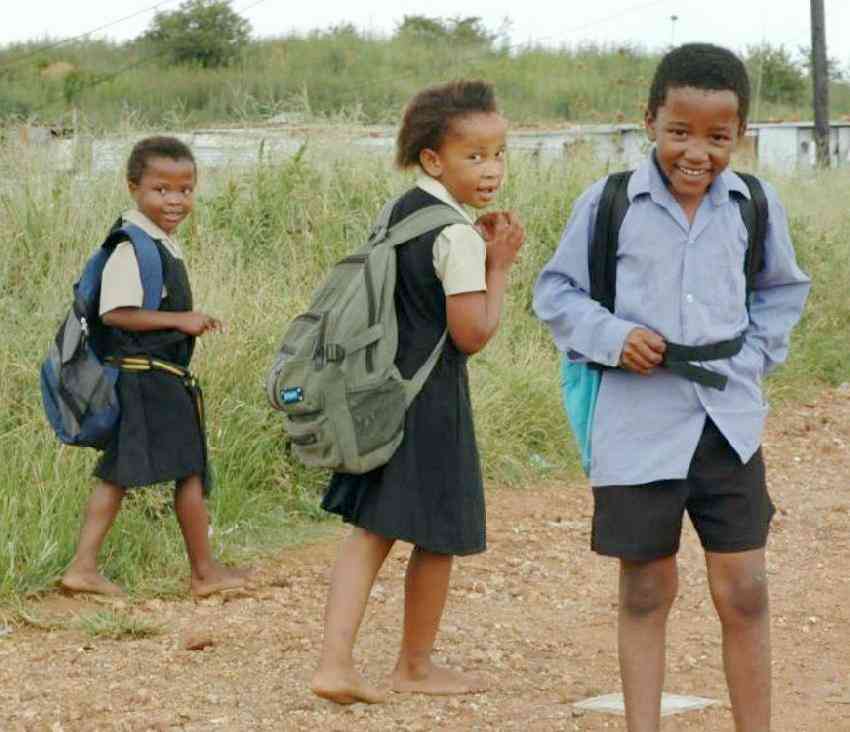
Figure 1.--According with the National Guideline, these South African children have to wear the school uniform, but they are allowed to attend in bare feet. |

|
Schools are strongly discouraged from having more than one uniform, which are used for different occasions or at different times of the year. This is unnecessary and has no educational value. No child may be refused admission to a school because of an inability to obtain or wear the school uniform. Schools should make an effort to assist pupils who are unable to afford a school uniform, and the use of second-hand shops run by schools is strongly encouraged.
Unwillingness to wear an approved school uniform must be treated as a disciplinary matter, in terms of the Code of Conduct.
A generous interpretation must be given to uniform specifications. The approved clothing should not have to be of a specified fabric, make or style, within reasonable limits.
Clothing for other purposes, such as physical education, arts and crafts, shall be simple and universally available. Shorts, T-shirts and suitable footwear are all that is required for most activities. No child should be excluded from an activity because of their inability to obtain or wear such clothing, within the usual bounds of safety and decorum.
Selection to a representative team of the school shall not require that the pupil obtain additional clothing at his or her own expense. Where a particular set of clothing is required, such as a “First X Strip”, the school shall endeavour to make this available to pupils elected to represent the school. Uniforms must take account of the circumstances of the school community, and be sensitive to these. Custom-designed ties and blazers will always be more expensive than generic styles, and should be discouraged. School badges can be attached to shirts using mechanisms like Velcro that allow shirts to be used for other schools. Uniforms must be sensitive to age: certain clothing e.g. T-shirts is better suited to earlier years. Schools must also be sensitive to climatic conditions. In warmer parts of the country, shorts and an open neck shirt with sandals must be preferred, instead of long trousers, tie and jacket. Pupils, especially in lower grades, should also be permitted to attend without shoes in hot weather. A safe and disciplined learning environment is one of the first requirements of a good school. Young people who are safe and secure, who develop basic Constitutional values and the essentials of good citizenship, are better pupils. In response to growing levels of violence in some of our schools, many parents, teachers, and school officials should see school uniforms as one positive and creative way to reduce discipline problems and increase school safety. The adoption of a school uniform could promote school safety, improve discipline, and enhance the learning environment. The potential benefits of school uniforms include:
Decreasing violence and theft -- even life-threatening situations -- among pupils over designer clothing or expensive footwear;
Helping prevent gang members from wearing gang colours and insignia at school; Instilling discipline in pupils; Helping parents and pupils resist peer pressure; Helping pupils concentrate on their school work; and Helping school officials recognize intruders who come to the school. A “Proudly South African” philosophy should be promoted. This could protect the local industry against cheap imports and would assist in bridging gaps between the formal and the informal economy. The role that “school uniforms” could play in assisting unemployed (especially rural people) gaining access to the economy must be explored. It is envisioned that persons participating in an Expanded Public Works Programme could produce school uniforms. The skills they develop could form the basis of establishing co-operatives for making school uniforms. Appropriate adult education programmes would assist in setting these up along sustainable-business lines.
Related Chronolgy Pages in the Boys' Historical Web Site
[Main Chronology Page]
[The 1900s]
[The 1910s]
[The 1920s]
[The 1930s]
[The 1940s]
[The 1950s]
[The 1960s]
[The 1970s]
Navigate the Relate Boys Historical Clothing Style Pages
[Main country page]
[Long pants suits]
[Short pants suits]
[Lederhosen]
[Kneesocks]
[Eton suits]
[Jacket and trousers]
[Blazer
[School sandals]
Navigate the Boys' Historical Clothing School Uniform Pages
[Return to the Main South African 2005 school uniform guidelines page]
[Return to the Main South African school page]
[Return to the Main School Uniform Page]
[Rturn to the Main National School Uniform Page]
[Australia]
[England]
[France]
[Germany]
[Ireland]
[Italy]
[Japan]
[New Zealand]
[Poland]
[Scotland]
[South Africa]
[United States]
Navigate the Boys' Historical Clothing Web Page
[Introduction]
[Activities]
[Biographies]
[Chronology]
[Clothing styles]
[Countries]
[Bibliographies]
[Contributions]
[FAQs]
[Glossaries]
[Images]
[Registration]
[Tools]
[Boys' Clothing Home]
Created: 7:21 AM 6/28/2009
Last updated: 7:22 AM 6/28/2009
